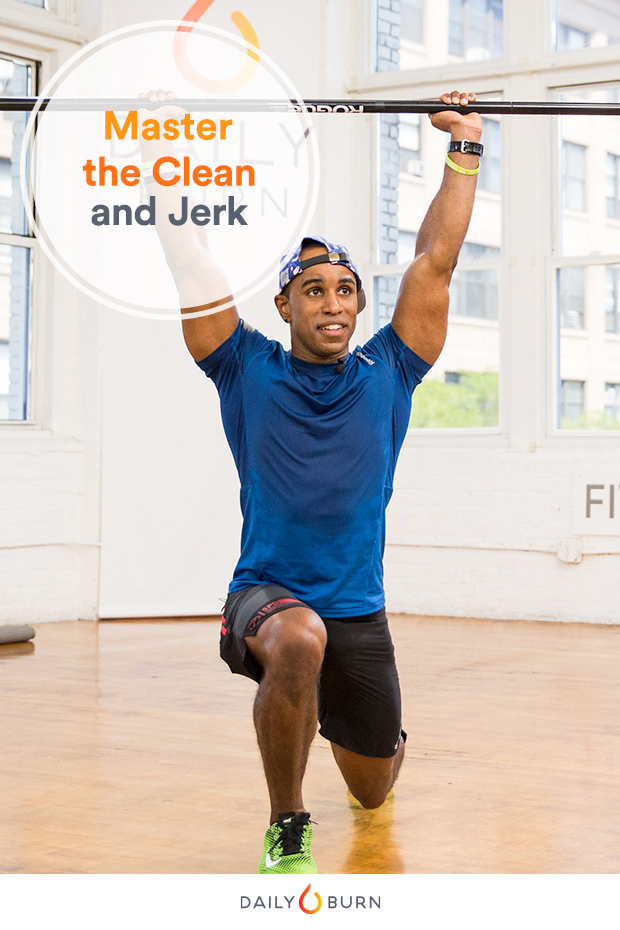
Now that you’ve mastered the barbell snatch, perhaps you want to take your weightlifting abilities even further. Next up: the clean and jerk. Like the snatch, the clean and jerk demands strength and cardiovascular endurance, but it takes things up a few notches with the addition of a split jerk (hello, plyometrics). And while the clean and jerk is comprised of two major movements, it’s usually broken down into six different steps. What, like that’s hard?
Good news is: “The beautiful thing about the clean and jerk is you can train and master the separate components first then put them together. Like the snatch, the clean and jerk is a whole-body move, but your quads, hamstrings, glutes, calves, core, triceps and shoulders are really kicking in,” Lisa Wheeler, head of fitness programming at Daily Burn, says.
But don’t get too excited to let it rip! Before you attempt this seriously challenging move, it’s important to nail down the basics of each step. Maybe that means perfecting your front squats, building up explosiveness with box jumps and plyo lunges, or getting comfortable stabilizing a barbell overhead.
For the clean, Wheeler recommends focusing on front loaded squats, deadlifts and dead pulls. “For the jerk, the push press and lunges are your friend.”
By developing more flexibility, speed and power, you’ll be able to propel your lift, hops and splits. Who knew weightlifting was such a science? Here, we break down these two powerful movements into six steps.
RELATED: Olympic Lifts 101: How to Do the Barbell Snatch
6 Steps to a Powerful Clean and Jerk
Phase 1: The Clean
1. Master your grip. Get into the deadlift position with your back straight and shoulders forward. Grip the barbell with your hands close to your body and your arms just outside the knees. “While there are several hand grip variations for the snatch as well as the clean and jerk, the most popular for the clean and jerk is a more narrow grip, a bit wider than shoulder-width,” Wheeler says. Your weight should be distributed in the midfoot. This position will set yourself up to power on the deadlift and hip drive, engaging your toes, calves, thighs, hamstrings and glutes.
2. First pull. Here’s where things get a little tricky. For the first pull, you want to drive up from the legs and get into what weightlifters call a triple extension, where you explode up from your ankles, knees and hips from the deadlift position to generate power. “You want to keep the bar close to your body and begin the movement with your lower body rather than pulling with your arms,” Wheeler says. This is where you end up on your toes with the bar close to the body and elbows are out.
3. Second pull. The second pull happens after the triple extension and when the shrug and “high row” come into play, according to Wheeler. Engage your hamstrings and lats to help propel the barbell up to shoulder height with your elbows bent and pointing out. “Once the shoulders and elbows are as high as they can go, you can begin the catch. This to me is the hardest part of the clean and jerk,” Wheeler says.
RELATED: 6 Squat Variations for Total-Body Strength
4. The catch. “When your shoulders are raised as high as they can go, you begin the catch phase,” Wheeler says. From the high row position, you’ll drop back into a half front squat with your feet slightly wider than hip-distance apart. At the same time, rotate your elbows, flip your wrists and get under the barbell and catch at the shoulders. Wheeler says, “Flipping your wrists will help you drop under the ‘catch’ and absorb the bar.” This is what’s called the rack position. You should also keep your upper arms parallel to the floor at the end of the catch and stomp on the ground as you land to connect into the floor, Wheeler recommends.
Phase 2: The Jerk
5. Sharpen your split jerk. Use the hip drive to bring yourself up to standing, keeping your hands in the same position. Here, weightlifters can sneak in a brief moment of recovery since the barbell is in rack position. But then the fancy footwork comes into play. You’ll want to drive through the heels and kick one of your legs back to get into a lunge. Keep your hips straight and aligned. At the same time, extend your arms and press the barbell up from shoulder height to overhead. As one of the most powerful steps of these two moves, Wheeler says to train with weighted forward and reverse lunges. “For compound move, you can practice the lunge with an overhead press and of course, the push press,” Wheeler suggests.
RELATED: 5 Power Lunges for Killer Glutes
6. Stay lifted. From the lunge, bring your back leg up to meet your front leg and drive your body up to standing. Keep the barbell overhead with your feet together and your core tight.
Want more strength workouts and training tips? Head to DailyBurn.com/365 to get new live workouts, daily.
